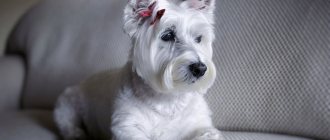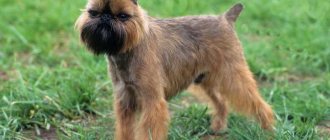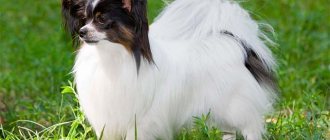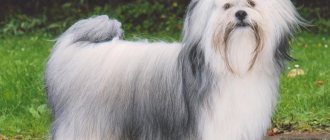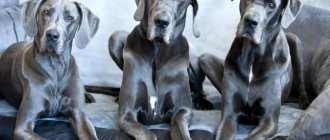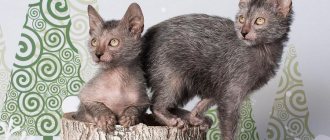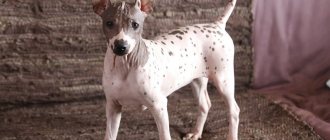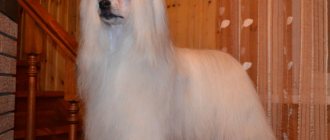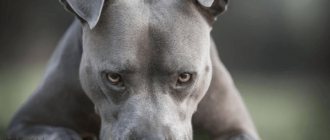Pomsky – Pedigree Hybrid of Siberian Husky and Pomeranian Spitz, which quickly won the love of many dog breeders!
Exclusive Designer Dog – POMSKY – Exclusive Designer Mini Dog
The hybrid inherited from its ancestors the best features of its exterior and character.
Origin story
Interspecific hybridization and crossbreeding have been used in dog breeding for a long time. The purpose of crossing is to obtain new working properties, character traits or conformation. The resulting offspring combines the traits of a pair of parents or several breeds that participated in the process of breeding a new breed.
Pomskys were specifically bred to be cute, miniature companions. To do this, representatives of Pomeranian Spitz and Siberian Huskies were crossed. Small dogs with the characteristic appearance of huskies are often confused with other mestizos of this breed - the Alaskan Klee Kai and the Siberian mini husky.
The first recorded information about the Pomsky appeared on the Internet. One of the users under the nickname Tammy turned to veterinary specialists on the website Justanswer.com with a question about possible breed diseases and the nature of the orange-husky mix, which his family planned to adopt from the shelter. A heated debate immediately broke out online about the possibility of such a hybrid appearing - after all, the baby’s parents differ greatly in size.
Hundreds of photographs of this mythical breed began to appear on the Internet, but none of them showed a Pomsky. However, the idea of creating a rare breed inspired breeders, and they began to experiment.
In 2011, the famous breeder Teresa Peterson from Burnsville (North Carolina, USA), specializing in breeding huskies, became interested in the possibility of breeding a new breed, and after 2 years the first litter was obtained. The puppies were officially registered.
Many breeders followed Peterson's example, and after some time there became a need for an organization that would monitor their activities. Thus, in 2013, the Pomsky Club of America (PCA) was organized, whose task was to maintain selection at a high level and the desire to achieve recognition of the Pomsky as an independent breed with its own standard.
So far, Pomskies have not been recognized by canine societies, and the activities of breeders are supported only by RCA and ACHC - the American Hybrid Dog Club.
Description of the Pomsky breed
The appearance of hybrids varies depending on the dominance of the genes of one or another parent. The instability of the exterior is also due to the fact that two purebred parents are involved in the creation of a Pomsky.
As a rule, a male Pomeranian is chosen for mating, and a female is a Husky, so that there are no problems with bearing puppies. The hybrid is obtained by artificial insemination. When the parents' genes mix, they produce the traits of the four breeds, which is why it is so difficult to predict the final result.
For convenience, the breeders divided the endless number of Pomsky variations into 5 groups.
The first one is a fox Pomsky and the dog looks like this:
- elongated body, like a husky;
- thin, characteristic Spitz-like bone structure;
- pointed muzzle;
- erect ears;
- smooth, medium-length fur of a reddish-red color.
The second group - Teddy Husky - the dog has:
- compact body of the orange;
- has a short muzzle;
- thick, curled tail;
- long, soft wool;
- The dog's color is characteristic of a husky.
The Third Group includes the White Pomsky, which is considered an extremely rare variety and has the following appearance features:
Description of the breed and what it looks like in the photo
Dogs born from crossing Huskies and Pomeranians are called Pomskys .
Teresa Peterson, a breeder from the USA, began seriously breeding these mestizos in 2011. She managed to get healthy puppies after 2 years.
Thus, the first Pomsky was officially bred in 2013, after which other breeders and breeders began developing the breed. After the massive appearance of these mestizos, the American Pomsky Club was founded.
There are 2 types of these mestizos:
- first generation (F1) – the parents of the puppies are purebred Huskies and purebred Spitz, such puppies inherit the traits of both parents equally;
- second generation (F2) - puppies are born as a result of mating of two individuals of the F1 generation, in such Pomskys the traits of only one of the parents are more pronounced, the qualities of the other are lost.
Regular mating of two individuals belonging to the first generation leads to the degeneration of the breed.
Pomskies are graceful dogs with a thick, soft outer coat and a short undercoat that retains moisture and protects the dog from heat and cold..
Puppies from different litters are completely different from each other and have a different set of characteristics. The biggest differences are in the weight and height of dogs, which depend on gender, the size of the parents and the litter.
Conventionally, these dogs are divided into 5 types:
- fox - dogs with medium-length red hair, a pointed muzzle, the long body of a husky and the thin skeleton of a spitz;
- plush - these dogs have a compact Spitz build, a short muzzle, a thick tail curled into a ring and a fluffy, soft husky coat with their own color;
- white - the rarest type of mestizos with short, thick, smooth coat of solid white color, the dogs are quite large in size and have a thin muzzle of medium length;
- brown with blue eyes - also a very rare hybrid with a semi-long double coat, strong bones, a moderately long muzzle and a brown nose;
- short-haired – short, fairly hard coat similar to that of a husky.
Since both Huskies and Spitz have a variety of coat colors, the Pomsky's coat also comes in several color variations and can be black and white, chocolate brown, black, silver gray, copper, fawn, white or sable.
A characteristic husky mask may be present on the face.
Due to the fact that to date it has not been possible to achieve consistency in the exterior features inherent in the Pomsky, Husky and Pomeranian mixes are not recognized by any canine association and are not considered an independent breed.
This is why there is no clear standard describing these dogs, which many unscrupulous breeders take advantage of.
What did you take from the husky?
The vast majority of the exterior and character traits inherent in the Pomsky are the result of crossing and interweaving the qualities that Huskies and Pomeranians possess separately..
Despite this, it is possible to highlight some features of mestizos that they inherited exclusively from huskies.
So, the Pomsky got his eyes, which can be blue, green, amber, brown and all their various shades, from a husky. From them, mestizos often inherit heterochromia.
The ring-shaped tail, erect, pointed ears and high degree of endurance also clearly indicate that one of the Pomsky's ancestors is a husky..
Speaking about character, one cannot fail to note the inherent stubbornness and willfulness of mestizos, which can significantly complicate the process of training these dogs, despite their developed intelligence and quick wits. Mestizos inherited all these traits from huskies.
What traits did she take from the Spitz?
The main exterior feature inherited from Pomskies by Spitz dogs is their small stature.
In addition, mestizo people inherited high intellectual abilities, a sharp mind, quick wit and the ability to learn from the Pomeranians.
Dimensions
The sizes of mestizos also vary. They can be small and quite large. To get an idea of the size of an adult hybrid, you need to divide the sum of the height at the withers of the puppy's parents in half.
Weight is 5-10 kg, height at the withers is ideally up to 30-35 cm. The size depends on the gender of the puppy, the dominant set of genes of one of the parents. In the first litter, the size of the puppies can be predicted, since the parents are purebred representatives of the breed. In the second litter, the variability is higher, since F1 Pomskies (first litter) are involved in mating.
How much does a puppy cost?
The price of a Pomsky puppy depends on the litter in which it is born . The cost of first-generation mestizos starts from 150 thousand rubles, the second – from 100 thousand rubles.
NOTE!
Due to the fact that this is a young breed, it is not very easy to purchase a Pomsky puppy; often unscrupulous breeders under the guise of a Pomsky sell Klee Kais that have a similar appearance.
DNA tests are sometimes performed to determine the breed..
Eyes
Eyes can also have different colors:
- yellow-brown;
- brown;
- nut green;
- blue.
There is heterochromia, in which the color of the iris of the right and left eyes is different, which often happens in huskies. With a partial anomaly of the iris, specks of a different color are “scattered” across the main color background.
It takes some time for the eyes to reach their final color. That's why nurseries have a waiting list. The buyer receives photographs or videos of available puppies to select the desired eye color.
Colors
The Pomsky comes in a variety of colors. The most common color is that of a husky with a mask on its face. The body has:
- black and white;
- grey-silver;
- brown;
- copper;
- pale yellow;
- tan;
- marble;
- white color;
- black color
There are both tan and solid colors. Less often - marble.
Character
Since Pomskies do not have established characteristics, and the breed line is in the process of formation, there are no fixed character traits. A puppy can inherit both the mother’s character and the father’s personality traits.
The energetic, independent, cautious, independent character of the Husky or the dominant, cocky, noisy, but affectionate and devoted character of the Pomeranian Spitz - it is not known in advance which of them will prevail. But what the Pomsky definitely doesn’t have is aggression. The dog is an excellent companion, ready to constantly be close to its owner. The Pomsky boldly rushes to the defense of its owner, forgetting about its “modest” size.
Pomsky gets along well with children and pets, especially growing up surrounded by them. He has a cheerful and sociable disposition, even the dog’s loud barking is a desire to draw the owner’s attention to himself or the situation, and not a sign of aggressiveness.
The dog has adopted from the Spitz the devotion and love for its owner, but, unlike the Pomeranian, the desire to constantly be around is not so strong. Therefore, the Pomsky is ideal as a companion for both families with children and singles in need of love and affection.
Health
Since Pomskies have not been fully studied, the list of possible diseases characteristic of the breed is not precisely known. Breeders claim that the crossbreed is in good health, problems with it arise in exceptional cases, and no genetic diseases have been detected at all.
The half Pomeranian half Husky, like other dogs, undergoes vaccinations and anti-parasitic procedures during puppyhood.
To roughly understand which area of the dog is more susceptible to various diseases and what to pay close attention to, you should study the possible diseases of Pomeranians and Huskies. It is equally important to visit your veterinarian frequently for checkups.
Training
Pomskies are easy to train because they are intelligent and quick-witted. But there are also stubborn people who inherit the independent character of the husky. Pomskies are capable of non-standard solutions, which makes training difficult. In order for the dog to accurately and obediently follow commands, patience and a benevolent attitude are necessary. Rudeness can ruin a dog's character - it will become irritable and withdrawn.
Pomsky is a little psychologist. He feels the emotional state of the owner and, with the intelligence characteristic of a dog, acts in accordance with it. Therefore, you cannot shout at the dog, much less raise your hand. Although the Pomsky's nervous system is quite stable, it can become offended, stubborn and uncontrollable.
If the animal is difficult to train, then you should contact a professional. With kind and persistent training, you can wean your Pomsky from constantly barking and responding with his voice when necessary or required.
Care and health
Pomskies are not particularly high maintenance. Their thick, soft coat is naturally protected from dirt and wetness, so the animal does not need frequent bathing. Pomskies should be washed no more than once a month, using a special shampoo according to the length of their coat. You can entrust this process to the staff of the grooming salon.
In addition to the mandatory care of your pet’s ears, eyes and teeth, he needs coat care. Pomskies need to be brushed regularly 2-3 times a week, and daily during seasonal shedding. Particular attention should be paid to the areas around the face and behind the ears, as long hair there is prone to matting. Claws need to be trimmed once every 2-3 weeks - as they grow.
Advantages and disadvantages
A cross between a Husky and a Spitz is still not widespread, but many breeders have already managed to evaluate this breed and determine the advantages and disadvantages of its representatives.
The advantages of these dogs include:
- beautiful exterior;
- intelligence and learning ability;
- independence;
- the ability to be alone;
- unobtrusive disposition;
- goodwill;
- devotion;
- lack of aggression;
- ability to get along with other pets and children.
Cons of a Pomsky:
- need for regular active walks;
- the need for careful care of the coat;
- tendency to howl.
In addition, these dogs are prone to the formation of tartar, so they need careful dental care.
Diseases
Mixed breeds are fairly healthy dogs, as they rarely inherit breed diseases typical of purebred parents. This phenomenon is explained by the effect of heterosis or “hybrid vigor”.
Breeders note that the Pomsky is characterized by the formation of tartar, so you need to monitor the pet’s oral health and regularly clean its teeth. In addition, Pomskies are predisposed to allergies, and eye diseases are quite possible in older dogs.
The Pomsky is not a “super dog,” so it can get sick, but illnesses are usually caused by improper care or maintenance. The dog needs routine vaccinations, deworming, treatment for external parasites and periodic veterinary examination. On average, Pomskies live from 13 to 15 years.
Diseases of the breed
One of the advantages of hybrid dogs is the absence of serious health problems and diseases caused by the genetic heritage of the breed. With a small degree of probability, a Pomsky can inherit diseases inherent in a Pomeranian or Husky:
- dental problems – tartar formation, caries;
- eye problems – retinal atrophy, corneal dystrophy, cataracts, glaucoma;
- atopic dermatitis, allergy;
- hypertension.
But overall this is a healthy dog. Of course, a pet can get sick with anything, especially if it does not receive proper attention and care. It should be remembered that prevention (vaccination) and regular examination by a veterinarian (every 6 months) are always more effective and cheaper than treatment.
Feeding
Pomskies are active dogs, so they need a complete, balanced, energy-rich diet. This can be achieved both with natural nutrition and with appropriate ready-made food.
When eating natural food, it is necessary to exclude from the diet:
- fat;
- smoked;
- sweets and baked goods;
- raw meat or fish.
The Pomsky's diet should include foods rich in vitamins and microelements. The calorie content of the food should be average, which is regulated by the amount of carbohydrates. With natural feeding, it is mandatory to take vitamin-mineral complexes to replenish the daily need for minerals.
Dry food makes feeding your pets easier and does not require additional vitamins. The only thing is that when feeding dry food, the animal must have a sufficient amount of fresh water.
It is recommended to purchase ready-made diets from the premium and super-premium categories. When feeding dry food, you can diversify the menu with wet canned food with different flavors, but it is advisable to purchase the same brand of wet and dry food.
Life expectancy and health
The average life expectancy of a Pomsky is 13-14 years . This is a young and little-studied dog breed, so there is not yet a complete list of diseases to which these animals are prone.
According to Pomsky breeders and breeders, these dogs have good health and do not have hereditary pathologies.
This is confirmed by the so-called hybrid resistance - the concept according to which mestizos do not have a tendency to breed diseases of their ancestors.
However, this does not mean that representatives of this breed are immune to all diseases. They often experience cases of allergic reactions and dental problems.
To avoid the development of other pathologies, it is necessary to provide the pet with proper care and proper living conditions.
Content
The small size of decorative dogs allows them to feel comfortable even in a small city apartment. Dogs easily adapt to new surroundings. The dog must have an equipped sleeping place, toys, and a place to eat.
These dogs are not adapted to life on the street, and it is unlikely that the owner will keep a rare, expensive dog outside the house. This will be quite enough for the dog, provided that it is walked regularly and for a long time.
You need to walk your Pomsky for at least 40-60 minutes, providing the dog with active games. In good weather, you need to go for a walk 2-3 times a day, and in bad weather, you can learn new commands with your dog at home. In addition to mandatory walks and games in the fresh air, you need to engage in training, training or intellectual development with your dog.
